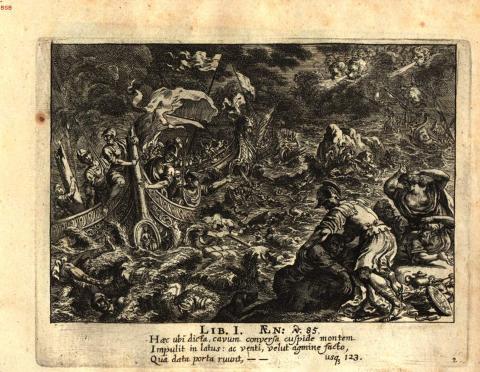Annotations
The winds fall upon the Trojan fleet, which is in distress at sea; the shipwrecked men are saved on shore.
Die Winde fallen über die trojanische Flotte her, die in Seenot gerät; Schiffbrüchige retten sich ans Ufer. (Suerbaum)
Engraving from a German children’s picture-book version of the Aeneid by G. J. Lang and G. C. Eimmart, “A tapestry of Roman virtues as seen in Vergil’s Aeneas and his brave deeds, rendered in sparkling engravings, as illustrations of the remarkable deeds of antiquity, for the common benefit of noble youth,” (Peplus virtutum Romanarum in Aenea Virgiliano eiusque rebus fortiter gestis, ad maiorem antiquitatis et rerum lucem, communi iuventutis sacratae bono, aere renitens) (Nuremburg: J.L. Buggel, 1688), pl. 2.
Online Resources
Associated Passages
License
Creative Commons Attribution-NonCommercial-ShareAlike
Properties
Agent
Date
1688
Culture
Medium
Dimensions
21.86x16.92cm
Inscription
Lib. I. Aen: v. 85 Haec ubi dicta, cavum conversa cuspide montem/ Impulit in latus: ac venti, velut agmine facto,/ Qua data porta ruunt, - - / usque 123.
Location
Bavarian State Library, Munich
Image Credit


In the right foreground a Trojan pulls his shipwrecked comrades out of the water, with the remnants of his spoils from Troy lying on the ground behind him, the Troia gaza of 119. In the water are bodies and pieces of flotsam and jetsam, battered ships with broken masts, a reef, possibly the Aras of line 109, to which some men cling. (Lucy McInerney)